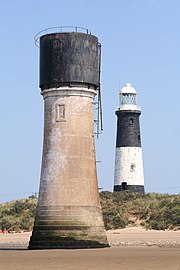Spurn
| Spurn | |
|---|---|
 Spurn in May 2005, showing the lighthouse and sand-dunes. | |
Location within theEast Riding of Yorkshire | |
| Population | 50 (approx) |
| OS grid reference | TA399108 |
| Civil parish | |
| Unitary authority | |
| Ceremonial county | |
| Region | |
| Country | England |
| Sovereign state | United Kingdom |
| Post town | HULL |
| Postcode district | HU12 |
| Dialling code | 01964 |
| Police | Humberside |
| Fire | Humberside |
| Ambulance | Yorkshire |
| UK Parliament | |
Spurnis a narrow sandtidal island[1]located off the tip of the coast of theEast Riding of Yorkshire,England that reaches into theNorth Seaand forms the north bank of the mouth of theHumber Estuary.It was aspitwith a semi-permanent connection to the mainland, but a storm in 2013 made the road down to the end of Spurn impassable to vehicles at high tide.[2]
The island is over three miles (five kilometres) long, almost half the width of the estuary at that point, and as little as 50 yards (45 metres) wide in places. The southernmost tip is known asSpurn HeadorSpurn Pointand was, until early 2023, the home to anRNLIlifeboatstation and two disused lighthouses.[3]It forms part of thecivil parishofEasington.
Spurn Head covers 280 acres (113 hectares) above high water and 450 acres (181 hectares) of foreshore. It has been owned since 1960 by theYorkshire Wildlife Trustand is a designatednational nature reserve,heritage coastand is part of the Humber Flats, Marshes and CoastSpecial Protection Area.
History[edit]
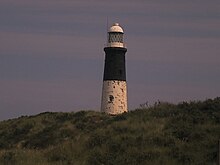
Spurn Head was known to classical authors, such asPtolemyasOcelum Promontorium(Ancient Greek:Ὀκέλον ἄκρον).[4][5]In the Middle Ages, Spurn Head was home to the port ofRavenspurn(a.k.a. Ravenspur or Ravensburgh), whereHenry of Bolingbrokelanded in 1399 on his return to dethroneRichard II.It was also where SirMartin de la Seeled the local resistance againstEdward IV's landing on 14 March 1471, as he was returning from his six months' exile in the Netherlands.[6]An earlier village, closer to the point of Spurn Head, wasRavenser Odd.Along with many other villages on theHoldernesscoast, Ravenspurn and Ravenser Odd were lost to the encroachments of the sea, as Spurn Head, due to erosion and deposition of its sand, migrated westward.[7]

Thelifeboat stationat Spurn Head was built in 1810. Owing to the remote location, houses for the lifeboat crew and their families were added a few years later. By the 1870s a room in the high lighthouse was being used as a chapel for the small residential community on Spurn Head, serving 'the keepers, coast-guardsmen and fishermen who live at the Point'.[8]
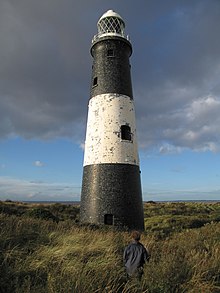
During theFirst World Wartwocoastal artillery9.2-inch (230 mm)batterieswere added at either end of Spurn Head, with 4-and-4.7-inch (100 and 120 mm) quick-firing guns in between. The emplacements can be clearly seen, and the northern ones are particularly interesting ascoastal erosionhas partly toppled them onto the beach, revealing the size of the concrete foundations very well.
As well as a road, the peninsula also used to have arailway,parts of which can still be seen. Unusual 'sail bogies' were used as well as more conventional light railway equipment.[9]
Following atidal surgein December 2013 the roadway became unsafe, and access to Spurn Point is on foot only, with a warning not to attempt this when exceptionally high tides are due.[10][11]Spurn has now become atidal island,as the narrowest part of the sandbank connection to the mainland is flooded with each high tide.[12]
Plans to build a new visitor centre for the reserve were unveiled in September 2014 by Yorkshire Wildlife Trust (YWT).[13][14]Planning consent for the initial plans was refused byEast Riding of Yorkshire Councilin July 2016[15]but revised plans were approved in January 2017.[16]These plans face local opposition because of the perceived feeling of commercialisation of the reserve by YWT, with plans to build extensive car park facilities, no longer free.[17]The new visitor centre was officially opened bySimon Kingon 20 March 2018.[18]
A February 2023 inspection of the RNLI launch jetty revealed structural issues, as a result the station was moved toGrimsby.[19]
Geography[edit]
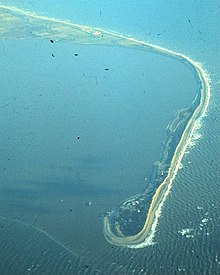
The spit is made up from sand, shingle andboulder clayeroded from the Holderness coastline washed down the coastline fromFlamborough Head.Material is washed down the coast bylongshore driftand accumulates to form the long, narrow embankment in the sheltered waters inside the mouth of the Humber Estuary. It is maintained by plants, especiallymarram grass(Ammophila arenaria). Waves carry material along the peninsula to the tip, continually extending it; as this action stretches the peninsula it also narrows it to the extent that the sea can cut across it in severe weather. When the sea cuts across it permanently, everything beyond the breach is swept away, only to eventually reform as a new spit pointing further south. This cycle of destruction and reconstruction occurs approximately every 250 years. More recently, Dr. John Pethick of Hull University put forward a different theory to explain the formation of Spurn Head. He suggests that the spit head has been a permanent feature since the end of thelast ice age,having developed on an underwater glacialmoraine.As the ice sheets melted, sea level gradually rose and longshore drift caused a spit to form between this and other islands along the moraine. Under normal circumstances, the sea washes over the neck of the spit taking sand from the seaward side and redepositing it on the landward side. Over time, the whole spit, length intact, slips back – with the spit-head remaining on its glacial foundation. This process has now been affected by the protection of the spit put in place during theVictorian era.This protection halted the wash-over process and resulted in the spit being even more exposed due to the rest of the coast moving back 110 yards (100 metres) since the 'protection' was constructed. The now crumbling defences will not be replaced and the spit will continue to move westwards at a rate of 6 feet 7 inches (2 metres) per year, keeping pace with the coastal erosion further north.
The second of theSix Studies in English Folk Songcomposed in 1926 byRalph Vaughan Williams,theAndante sostenutoin E flat "Spurn Point" celebrates this peninsula.
It was featured on the television programmeSeven Natural Wondersas one of the wonders of Yorkshire.
Ecology[edit]
The landward-side mud flats are an important feeding ground forwading birds,and the area has abird observatory,for monitoringmigratingbirds and providing accommodation to visiting birdwatchers. Their migration is assisted by east winds in autumn, resulting indrift migrationofScandinavianmigrants, sometimes leading to a spectacular "fall" of thousands of birds. Many uncommon species have been sighted there, including acliff swallowfrom North America, alanceolated warblerfrom Siberia and ablack-browed albatrossfrom the Southern Ocean. More commonly, birds such asnorthern wheatears,whinchats,common redstartsandflycatchersalight at Spurn on their way between breeding and wintering grounds elsewhere. When the wind is in the right direction migrants are funnelled down Spurn Point and are counted at the Narrows Watchpoint, more than 15,000 birds can fly past on a good morning in autumn with 3,000 quite normal.
Lighthouses[edit]
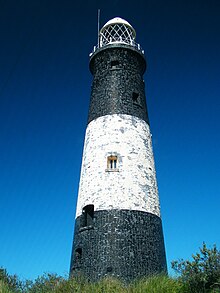 Spurn Point | |
 | |
| Location | Spurn Point East Riding of Yorkshire England |
|---|---|
| OS grid | TA4034511239 |
| Coordinates | 53°34′44″N0°07′06″E/ 53.578996°N 0.118325°E |
| Tower | |
| Constructed | 1895 |
| Designed by | Thomas Matthews |
| Construction | brick tower |
| Automated | 1957 |
| Height | 128 ft (39 m) |
| Shape | cylindrical tower with balcony and lantern |
| Markings | white and black bands tower, white lantern |
| Operator | Spurn Point National Nature Reserve[20] |
| Heritage | Grade II listed building[21] |
| Light | |
| Deactivated | 1985 |
| Lens | 6-panelhyper-radialrotatingcatadioptric |
| Range | 17 nmi (31 km) |
| Characteristic | Fl W 15 s Oc RW (sector lights) |
The earliest reference to a lighthouse on Spurn Point is 1427. From the 17th century there are records of a pair of lighthouses being maintained asleading lights:a high light and a low light.
Old High and Low Lights[edit]
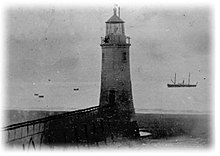
In 1767,John Smeatonwas commissioned to build a new pair of lighthouses. Smeaton's high light (a 90-foot [27 m] tower) remained in use until 1895, but there were problems (as there had been in previous years) with maintaining the low light; within a short time it had been washed away by the sea. A series of more-or-less temporary replacements were used in the years that followed, until a more solid lighthouse designed byJames Walker[22]was constructed in 1852 under the supervision of engineerHenry Norris.[22]Unlike its predecessor this low light was built the estuary side (i.e. to the west) of the high light, rather than on the seaward side.
Initially both lighthouses were coal-fired. In 1819 Smeaton's high light was equipped with 24Argand lampsandreflectors);[22]later, in 1853, it was fitted with a newFresnel lens:a large (first-order) fixed optic by Henry Lepaute of Paris. (Prior to installation this lens had been exhibited at theGreat Exhibition of 1851).[23]Later, a redsectorwas added to the high light, which warned ships of hazards to the south ranging fromClee Nessto Sand Haile Flats.[24]
The low light, meanwhile, had also been fitted with oil lamps and reflectors in 1816. Then, in 1848, a small Fresnel lens (a fifth-orderlenticular dioptric) had been installed, which was reused when the new tower was built in 1852.[22]
In 1895 both this low light and Smeaton's high light were decommissioned and replaced by a single lighthouse which still stands on the grass of Spurn Head. The 1852 low light also still stands on the sandy shore of the island, though its lantern has been replaced by a large water tank. (Of the old Smeaton high light only the foundations remain;[25]after dismantling, its optic was re-used in the high lighthouse atNash Point,where it was installed as part of a programme of improvements.)[26]
The new Spurn Lighthouse[edit]
The 1895 lighthouse is a round brick tower, 128 feet (39 metres) high, painted black and white. It was designed byThomas Matthews.The lantern contained a very large revolvinghyper-radiant opticbyChance Brothers & Co.[27]Its white light had a range of 17 nautical miles (31 kilometres) and displayed a flash once every 20 seconds. In addition there were separate sector lights, two of which marked particular shoals or sandbanks, while another indicated the main channel along the Humber. Initially oil-lit, the lighthouse was converted to electricity in 1941 to enable the light to be lit briefly (as and when requested by allied ships and convoys) and then extinguished.[28]
Then, in 1957, the lighthouse was converted to acetylene gas operation.[29]A new, smaller, gas-driven revolving optic was installed, which flashed once every fifteen seconds; and the subsidiary lights were provided withoccultingmechanisms, also gas-driven. The new systems were automated; the keepers therefore moved out and their cottages were demolished.[28]
Due to improvements in navigation, the light was discontinued in 1985; the main optic was removed the following year.[27]The combined acetylene lamp and gas-powered optic were subsequently put on display, first in theTrinity House National Lighthouse Museum,then in theNational Maritime Museum Cornwall.[30]Since 1986, the lighthouse remained empty, but in 2013,Yorkshire Wildlife Trustwas awarded a £470,500 grant to restore the lighthouse with a view to its being reopened as a visitor centre. This was scheduled to take place in 2015,[31]with work starting in April 2015.[32]The work was completed in March 2016, and opened to the public for the Easter weekend.[33]
Gallery[edit]
-
The pier and launching platform for the RNLI at Spurn
-
Sea mist
-
HumberVessel traffic service
-
Spurn Point from the mainland
-
The old Low Light (1852) seen alongside the new (1895) lighthouse
-
The 1957 optic in the National Maritime Museum
-
Humber Vessel traffic service
-
RNLI Platform
See also[edit]
References[edit]
- ^May, V. J."Spurn Head"(PDF).defra.gov.uk.Geological Conservation Review. p. 2. Archived fromthe original(PDF)on 20 June 2017.Retrieved24 June2017.
- ^Ratcliffe, Roger (29 October 2016)."Letting nature take its course: Why they're no longer defending Spurn Point".The Yorkshire Post.Retrieved24 June2017.
- ^"Nostalgia on Tuesday: Point of interest".The Yorkshire Post.20 November 2018.Retrieved23 May2020.
- ^Ptolemy,Geography,2.3.6.
- ^
 Smith, William,ed. (1854–1857). "Ocelum".Dictionary of Greek and Roman Geography.London: John Murray.
Smith, William,ed. (1854–1857). "Ocelum".Dictionary of Greek and Roman Geography.London: John Murray.
- ^Bruce, J. (1838).Historie of the Arrivall of Edward IV.Camden Soc. 1. p. 4.OCLC602067.
- ^"History of Ravenser Odd".Archived fromthe originalon 8 May 2009.Retrieved15 August2011.
- ^Elliot, George H. (1875).European Light-House Systems.London: Lockwood & co. pp. 115–116.Retrieved10 March2019.
- ^"Sails on Rails".Mike Munro.Retrieved8 July2009.
- ^"Spurn National Nature Reserve".Yorkshire Wildlife Trust.Retrieved23 January2015.
- ^"Spurn, Yorkshire's 'Land's End' five years on".BBC News.26 December 2018.Retrieved26 September2019.
- ^"Holderness, Countryfile – BBC One".BBC.Retrieved23 July2017.
- ^Longhorn, Danny (29 September 2014)."Visitor centre plan for Spurn Point Nature Reserve".Hull Daily Mail.Retrieved23 January2015.
- ^"The Spurn Visitor Centre"(PDF).Spurn Newsletter.No. 1. Yorkshire Wildlife Trust. September 2014. pp. 1–4.Retrieved23 January2015.
- ^"East Yorkshire wildlife visitor centre plan rejected".BBC News.18 July 2016.Retrieved29 January2017.
- ^"Spurn gets go-ahead for wildlife visitor centre".BBC News.26 January 2017.Retrieved29 January2017.
- ^"Spurn visitor centre plans sparks opposition".Retrieved23 July2017.
- ^"Spurn wildlife visitor centre opens despite objections".BBC News.20 March 2018.Retrieved6 October2019.
- ^"Humber lifeboat station leaves Spurn Point after 213 years of rescues".BBC News.1 June 2023.Retrieved30 September2023.
- ^Rowlett, Russ."Lighthouses of Eastern England".The Lighthouse Directory.University of North Carolina at Chapel Hill.Retrieved6 May2016.
- ^Historic England."Spurn Lighthouse (Grade II) (1083476)".National Heritage List for England.Retrieved21 May2021.
- ^abcd"Lighthouse management: the report of the Royal Commissioners on Lights, Buoys, and Beacons, 1861, examined and refuted Vol. 2".1861. p. 69.
- ^"Lighthouse management: the report of the Royal Commissioners on Lights, Buoys, and Beacons, 1861, examined and refuted Vol. 1"(PDF).p. 30.
- ^Admiralty Chart: Entrance to the River Humber 1875
- ^de Boer, G. (1984) [1968].A History of the Spurn lighthouses(PDF).East Yorkshire Local History Society.Retrieved23 June2014.
- ^Mercantile Marine Fund: Minutes of Evidence Taken Before the Committee of Inquiry appointed by the President of the Board of Trade.London: HMSO. 1896. p. 281.
- ^ab"Hyper-radial Lenses".United States Lighthouse Society.Retrieved11 March2019.
- ^abJones, Robin (2014).Lighthouses of the North East Coast.Wellington, Somerset: Halsgrove. pp. 122–128.ISBN978-0-85704-234-7.
- ^"Spurn Point".Visit Hull and East Yorkshire.Retrieved11 March2019.
- ^"Photo".Alamy.Retrieved20 March2019.
- ^"Spurn Point lighthouse gets lottery renovation".BBC News.18 September 2013.Retrieved23 June2014.
- ^"Spurn Point lighthouse revamp work gets under way".BBC News.10 April 2015.Retrieved9 August2016.
- ^"Spurn Lighthouse opens to the public!".Yorkshire Wildlife Trust. 30 March 2016.Retrieved20 March2018.
Further reading[edit]
- Gazetteer – A–Z of Towns Villages and Hamlets.East Riding of Yorkshire Council. 2006. p. 10.
External links[edit]
- Pages using infobox lighthouse with custom Wikidata item
- National nature reserves in England
- Special Protection Areas in England
- Islands of the Humber
- Humber
- Nature reserves in the East Riding of Yorkshire
- Yorkshire Wildlife Trust reserves
- Bird observatories in England
- Yorkshire coast
- Spits of England
- Easington, East Riding of Yorkshire


